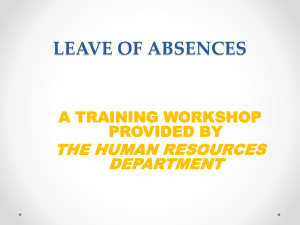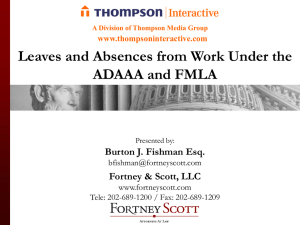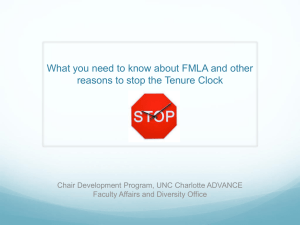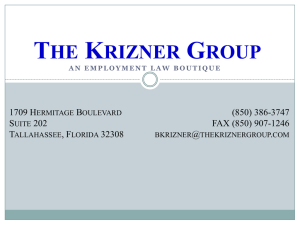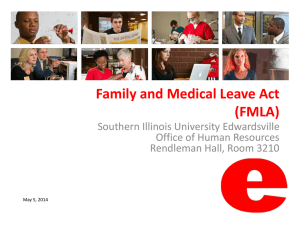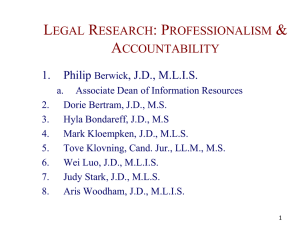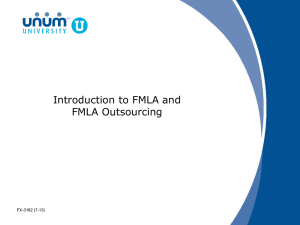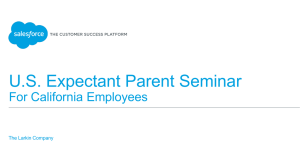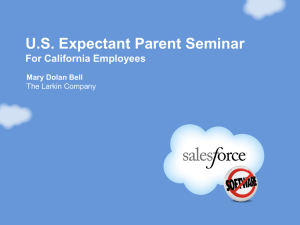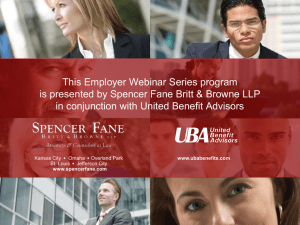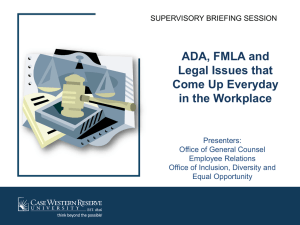FMLA - Odle Management
advertisement
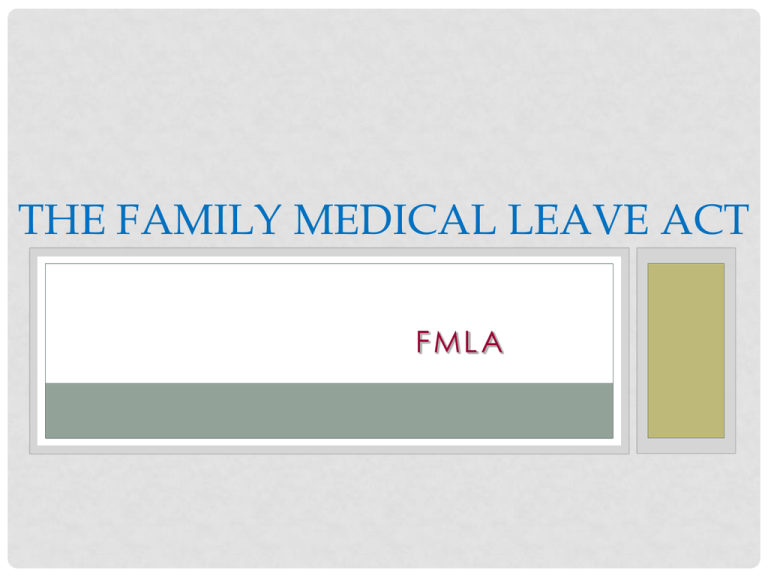
THE FAMILY MEDICAL LEAVE ACT FMLA FMLA 1. 2. 3. 4. What is it? Who is eligible? What types of leave are covered? What are employer and employee obligations under the FMLA? 5. What about intermittent and reduced leave? 6. Benefits and Reinstatement 2 FMLA: WHAT IS IT? • 1993 Federal Law: Applicable to all private employers with 50 or more employees. Eligible employees have three basic rights: 1. 2. 3. Absolute entitlement to a total of 12 weeks (total of 480 hours) of leave for one or more qualifying reasons within a rolling 12 month period. Any additional leave after the 12 weeks is NOT FMLA leave unless it is military care giver leave which allows the employee 26 weeks of leave in a rolling 12 month period. Right to have health benefits continued during leave on same basis as if working. Absolute right to reinstatement to same or equivalent job. 3 FMLA: WHAT IS IT? • Keep in mind that FMLA leave is only 12 weeks (480 hours). If an employee is out longer than 12 weeks, the time does not count as FMLA leave and is not protected by the statute unless it is qualified military care giver leave. • If an employee will be out for more than 12 weeks (or 26 weeks for military care givers), they must request personal leave through the Company’s personal leave policy and complete a separate application form. 4 FMLA: WHAT QUALIFIES? • The care of a child after birth, or placement of a child for adoption or foster care. • The care of a spouse, child or parent with a serious health condition. • An employee’s own serious health condition that makes the employee unable to perform essential functions of the job. 5 FMLA: WHAT QUALIFIES? • Leave to care for a family member injured in the line of active duty (up to 26 weeks). • Qualifying Exigency Leave (the spouse, son, daughter or parent of the employee is on active duty, or has been notified of an impending call to active duty status, in support of a contingency operation.) 6 FMLA: WHO IS ELIGIBLE? • Eligibility guidelines: 1. Employed for at least 12 months (need not be consecutive). 2. Worked 1,250 hours during the twelve months prior to the leave request • Refers to actual hours worked. • Note that military service must be credited as actual hours worked. 3. Works at a facility with 50 or more employees within a 75 mile radius. 7 FMLA: WHO IS ELIGIBLE? HOURS WORKED DOES NOT INCLUDE: • Vacation • Holidays • FMLA time • Sick Leave • Any other paid or unpaid time off • BUT – military leave does count. 8 FMLA: WHO IS ELIGIBLE • 12 weeks in 12 months? • Can be calendar, anniversary, FMLA leave year, or rolling back. • We use Rolling 12 month period • Example: Employee requests leave beginning May 10, 2010. We would look back 12 months to determine how many hours are available (May 10, 2009 - May 10, 2010). If the employee has used any hours in the previous 12 months we would deduct those hours going forward. • Example: Employee used 60 FMLA hours during August & September 2009. The same employee is now requesting a leave beginning May 10, 2010. The employee would have a total of 420 (480 - 60) hours available beginning May 10, 2008. 9 FMLA: COVERED LEAVE • • • • New Child Serious Health Condition Military Care Giver Qualifying Exigency 10 FMLA: CHILD CARE • Child Care Leave: Must be taken within 1 year after birth, placement or adoption. • Child means 18 years of age or younger unless the child is incapable of self-care due to an ADA disability. • If circumstances require, may begin before birth, adoption or placement. • Includes not only biological, adopted, foster or stepchild, but also one for whom the employee has actual, day-today responsibility. 11 FMLA: SERIOUS HEALTH CONDITION • A serious health condition of: • Employee • Employee’s spouse • Under the FMLA, “spouse” does NOT include unmarried, domestic partners. (However, CFRA includes domestic partners.) • Employee’s child (under 18 unless disabled) • Employee’s Parent • If both parents work for LBJCC, we limit combined leave to total FMLA limit = 12 weeks. 12 FMLA: SERIOUS HEALTH CONDITION Illness, injury, impairment or physical or mental condition that involves inpatient care or continuing treatment. 13 FMLA: EMPLOYEE OBLIGATIONS • Must inform employer of potentially qualifying reason. Employee is obligated to respond to questions designed to determine whether absence is FMLA qualifying. • If foreseeable, must give 30 days notice of need for leave. • If not foreseeable, must give notice as soon as practicable. • Note – employee who calls in “sick” has not given sufficient notice to trigger FMLA. 14 FMLA: EMPLOYEE OBLIGATIONS • The employee has an obligation to respond to employer’s questions designed to determine whether an absence is potentially FMLA qualifying. If employee fails to respond, we can deny FMLA protection. 15 FMLA: FITNESS FOR DUTY • What if the employee fails to provide the fitness for duty certification upon return? • Reinstatement can be delayed and, if never received, employee may be terminated (not applicable to intermittent leaves). 16 FMLA: PAID OR UNPAID? • Statute does not require paid leave. • You can use paid leave if you have any available • Note: Short Term Disability and Workers’ Compensation leaves run concurrently with FMLA if they otherwise qualify. If the leave is FMLA qualifying, the employee must receive FMLA job and benefit protection. 17 FMLA: INTERMITTENT/REDUCED LEAVE • Intermittent: Leave taken for a few days or even a few hours due to a single qualifying event; generally unplanned leave. • Reduced Schedule: A temporary reduction of usual number of working hours per day or week. 18 FMLA: INTERMITTENT LEAVE When is intermittent leave required? • • An eligible employee must generally be allowed to take intermittent leave when it is medically necessary for their serious health condition, a family member’s serious health condition, a chronic serious health condition, or military care giver or qualifying exigency leave. • An employer is not required to allow intermittent or reduced leave for purposes of birth, adoption, child care leave . 19 FMLA: INTERMITTENT LEAVE • What are responsibilities when leave is foreseeable? • If need for intermittent leave is foreseeable, such as a planned medical treatment – employee must attempt to schedule leave in advance to minimize disruptions to LBJCC operations. • If unforeseeable? • If need is not foreseeable, no requirement that employee schedule leave in advance. 20 FMLA: BENEFITS • Group health insurance continues during family and medical leave. We must notify employee of any plan changes or open enrollment. • Employee’s responsibility for premiums on same basis as when regularly working. • No other benefits are required to be continued during FMLA leave, but employees must be reinstated to benefit plan upon return from leave. • Employees on leave keep accrued benefits. 21 FMLA: REINSTATEMENT EMPLOYEE MUST BE REINSTATED TO SAME OR EQUIVALENT POSITION. Equivalent Means: • Same pay and benefits; • Substantially similar status, responsibility, skill and authority; • Same Shift; • Reasonable commuting distance. • Practical Pointer: Can an employee’s job be filled while on FMLA? Yes, but the employee must still be reinstated to an equivalent position. 22 FMLA: REINSTATEMENT • Are there any exceptions to reinstatement? • If the employee would have been laid off/terminated if actively employed, the employee has no reinstatement rights. • If the employee is unable to perform essential job function – but within ADA requirements. • If the employee fails to provide fitness for duty certification. • Key Employees: Among highest paid 10% of all employees. Not entitled to reinstatement if it would cause “substantial and grievous economic injury.” 23 FMLA: REINSTATEMENT • Note that if an employee returns to work in a light duty position, that is not counted as FMLA leave. At the end of light duty, the employee is entitled to restoration in the same or equivalent position he left before he took light duty position. • Right to restoration ends at the end of the applicable 12 month leave year. 24 QUESTIONS? 25
